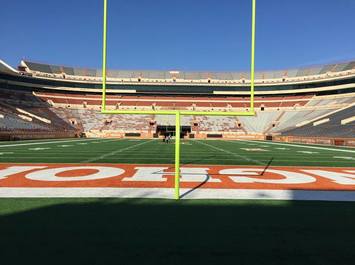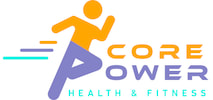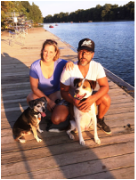STRETCH & REST CARE for the wellness warrior |
 Cooler temps. Tailgaters out. The beer is flowing. Welcome to concussion season, I mean football (or futbol) season. It’s in full swing! Hopefully you saw the movie Concussion that shed light on the story of how the NFL finally acknowledged that their players are at risk for some serious brain damage (chronic traumatic encephalopathy or CTE) from the repetitive hits to the head they endure throughout their careers. The movie told the story well but glossed over how you can decrease the risk for CTE by actually managing concussions in a different way. The brain is not a muscle but it bruises somewhat like a muscle does when injured. Sprain your ankle and it bruises, swells, hurts. You can’t put weight on it so you don’t walk. You slowly put more weight on it as it heals. What bruising looks like in the brain is headache, dizziness, nausea, difficulty reading, irritability in noisy environments, light sensitivity, memory issues, confusion etc. While it’s healing, the brain needs to avoid taking another hit. It needs time to recover. Rest is key. Unlike a sprained ankle, you can’t see it so it’s hard to decide when it’s safe to go back to normal activities. Ender and I get calls this time of year from our friend’s with kids in sports. A lot of soccer and football parents. The kids seem younger and younger. It’s the same scenario. Their kid got a concussion and was told not to play until they felt better. The parents aren’t sure when to let them go back to practice. Their kid is still having headaches when they try to read or in class, they feel funny when they run and/or they don’t have much energy. Although we don’t offer medical advice, here is some information and resources that we share with them (besides reminding them to always consult their physician). First, they need to advocate for their kid and put aside their concerns about their sports career. They are parents first, coach or manager second. This is a big deal. It’s their kid’s future with or without sports. They don’t want their kid to get another concussion while the other one is healing. It’s not like 1+1= 2. It’s 1 + another one (concussion) = 5. Brain damage is exponential. And keep in mind the brain isn’t fully developed until the mid 20’s (around age 26 for girls). What's a concussion really? A concussion is a mild traumatic brain injury. It’s caused by a jolt or blow to the head causing the brain to bounce around inside the skull. This stretches and damages brain cells and is sometimes referred to as shearing. It’s not going to necessarily show up on scans/MRI’s because it can be microscopic tears. 90% won’t lose consciousness. It can take 3-5 days to show signs. 50-70% go unreported. More than a third happen in practice. That means you’ve really got to be on the lookout for the symptoms of a concussion. Common symptoms include dizziness, double vision, confusion, nausea and sensitivity to light or noise. Also feeling sluggish, foggy, or down. You may notice they’re more emotional (angry, irritable, or crying), have changes in behavior or personality (an outgoing kid becomes more isolated), moving clumsily, and/or forgetful (in the game, they may forget their position or the score). There are 3.8 million sports related concussions a year. 1 in 5 school athletes will sustain one this year. Cycling is higher risk (25%) for concussion than football and baseball (14%). Did you see Annemiek Van Vleuten, the Dutch cyclist, crash in Women’s Road Race 2016 Rio Olympics? Yikes- please wear your helmet when cycling! Basketball’s (11%) next. There is less than a 10% risk for water sports, power RV, soccer, skateboards, fitness, or winter sports. Athletes with a recent concussion are approximately 2.5 times more likely to suffer a leg injury within 90 days after return to play compared to athletes without a concussion. Why? One reason might be because the brain controls our ability to move properly and whatever side of the brain was injured, the other side of the body could be more at risk for injury while it’s healing. Playing with a concussion also doubles recovery time. A recent study of 12 to 19 year olds playing contact sports found it took 22 vs 44 days to recover if they didn’t rest 24 to 48 hours after a concussion. Bottom line: proper rest after concussion will help you return to sport more quickly. Listen, I get it. The pressure to get back in the game is real. Even though I’ve been in brain injury rehab for over 20 years, I love football and we are UFC fanatics. I grew up in Texas with two younger brothers that were groomed to be the high school quarterback stars from the age 10. My brothers had pressure their whole childhood from our dad and coaches for all the sports they played. Our dad made dance moms look sane. My youngest brother hadn’t even woken up from anesthesia after a surgery to repair a compound fracture to his left leg from a freaky tackle his senior year and my dad was asking the trauma surgeon when he could play baseball. You see my dad was obsessed with him getting a baseball scholarship that he couldn’t even process that my brother might not be able to walk normal much less run. My brothers tell stories now of coaches pulling them out of class to talk about the games or pressure them to choose one sport (in high school). And they were healthy. If you’re an ill or injured athlete, there’s much more pressure to get back in the game or lose your spot. Even on the drill team we had that issue. If we didn’t practice, we couldn’t perform and you might not ever get back in the lineup. In reality, the worst pressure is probably coming from your kid because all they want to do is please their coach and you. They’re going to want to play so it’s your job to know what to look for. You know your kid best. You’re looking for changes in their personality, behaviors, mood, and routines. Until that gets back to normal, they probably shouldn’t practice much less play. Although schools and universities are more aware of the concussion issue, it really depends on what kind of economic resources your school has for how they handle return to play. It’s really up to the athlete and their parents to be on top of their “brain” game. It’s really no different than any other medical or health concern, the more you advocate for yourself, the better. You might need to seek medical help outside of the school. Elite athletes put together a team outside of their agent, manager, or league to take care of their body (and mind). It’s never too early to take this approach to sports. Even if your kid isn’t going pro, they’re going to want to have a healthy brain as they pursue college, work or a relationship. If your kid is playing a sport, figure out if your school has a protocol for concussions and what the return to play guidelines are. Find out if your area has a Concussion Clinic and tuck that into your back pocket. After a concussion, the typical recommendation is to slowly return to normal activities under the supervision of a physician. But honestly what does that mean? THE KEY IS TO GIVE THE BRAIN TIME TO HEAL! Here’s what you can do to assist the recovery if your kid does get a concussion in practice or a game:
SIGNS OF OVERDOING IT: onset of headache, fatigue, irritability, eye fatigue-blurred vision, dizziness, anxiety/worry, insomnia, difficulty focusing and remembering things either during or after activities. THE SOLUTION: If your activities bring on symptoms, the answer is rest and taking breaks. Also keep your physician informed and follow his advice. Notice how you feel the next day after trying new activities. If your symptoms have flared up, you may have overdone it the day before. It’s helpful to keep a calendar with your activities to refer to so you can adjust your pace as needed. SEEK PROFESSIONAL HELP SOONER RATHER THAN LATER: get professional help if symptoms last more than a month such as ongoing dizziness, headaches, vision issues, sensitivity to light and noise or mood issues. Also reach out if your kid had a concussion in the past and never really bounced back or something just seems off (maybe they are now struggling in school and hadn’t in the past). The sooner you get help, the better. Here are some resources:
THE GOOD NEWS: The brain can repair and heal because of neuroplasticity (ability to create new neurons/connections and compensate for injury or damage) if it’s given the right amount of rest balanced with just enough stimulation. It’s a dance but if you listen to the symptoms, they will guide you on how to pace your activities as the brain recovers. If you need some brain Injury resources for Texas, you can book a consult with me here. Play Smart! Mollie PLEASE NOTE: CORE POWER HEALTH & FITNESS, INC. (“WE,” “US” OR “OUR”) DOES NOT PROVIDE MEDICAL ADVICE. YOU SHOULD CONSULT A LICENSED PHYSICIAN PRIOR TO BEGINNING OR MODIFYING ANY EXERCISE, FITNESS, DIET OR NUTRITION PROGRAM THAT YOU UNDERTAKE. YOU ACKNOWLEDGE THAT EXERCISE ACTIVITIES INVOLVE RISKS WHICH MAY INVOLVE RISK OF BODILY INJURY OR DEATH, AND THAT YOU ASSUME THOSE RISKS. IN NO EVENT SHALL WE BE LIABLE FOR ANY INJURY THAT YOU SUFFER, OR THAT YOU CAUSE TO ANY PERSON OR ENTITY, IN CONNECTION WITH YOUR USE OF THE SITE.
1 Comment
|
Mollie Miller, PT
|
TERMS OF USE PRIVACY POLICY
Core Power Health & Fitness, Inc. does not provide medical advice. Consult a licensed physician prior to beginning any exercise or nutrition program.
Copyright © 2015 Core Power Health & Fitness Inc.
Core Power Health & Fitness, Inc. does not provide medical advice. Consult a licensed physician prior to beginning any exercise or nutrition program.
Copyright © 2015 Core Power Health & Fitness Inc.


 RSS Feed
RSS Feed